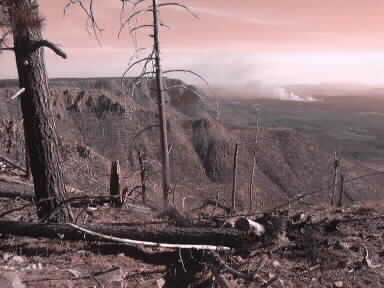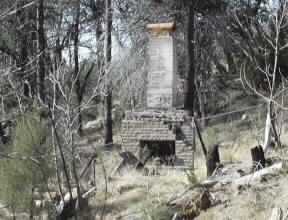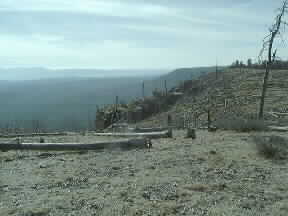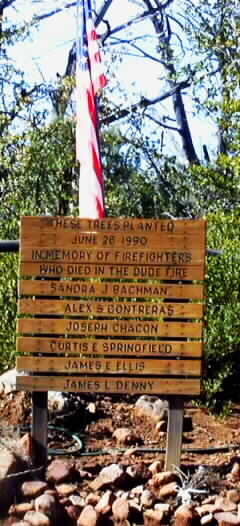|
(Continued from Part Two)
Some of the hazards they were warned of were downed power lines, fire weakened trees and containers of flammable liquids They were warned to be cautious of displaced animals, both wild and domestic. They were cautioned not to enter any fire-damaged structure. They were asked to wear boots, leather gloves and hard-hats in the burn area.
Jim told Mark he planned to move a mobile home onto the charred remains of his six acre spread and start over. "I'm gonna clean up this mess and rebuild. That's the story of my life." Jim said the destruction reminded him of German towns he saw while he was in the U.S. Army at the end of World War II.
Peter Best's house hadn't survived, though. The relentless heat from the fire had actually fused his refrigerator to his water heater! "The reason we built here," Best said, "was because of the trees." Having now lost the trees, he had decided to keep the land, but would not rebuild. His sad thoughts now centered on his kids, the next generation... maybe in time, they could use it someday. Another article by Mark Shaffer describes what some of the fire crew had experienced:
"Everyone started screaming to get out, and people just started running to the road." Moore said. "There wasn't even time to unwrap our fire shields. It was like being dropped into an incinerator in the dark." He lost sight of the firefighters from the Arizona State Prison at Perryville, five of whom - together with a prison staff member - were never seen again. That issue of the Arizona Republic, Thursday, June 28, 1990, has more coverage on the Dude Fire than any I've seen. I don't know if Mark Shaffer received any kind of award for his reporting of that fire, but he should have. Anyone who lived in the Rim Country at the time of the Dude Fire, or anyone who has since visited the burn area, or even read about this terrible conflagration cannot help but be moved by the stories of the brave men and women who fought to save our land and our lives, six of whom did so at the expense of their own. In memory of those brave and forever precious souls, I offer the following words, familiar undoubtedly to most of us, words given to us by a poet who also lost his life fighting for the lives of others. That poet was Sgt. Joyce Kilmer of the U.S. Army's 165th Infantry, the old "Fighting 69th", killed in action on July 30, 1918.
I think that I shall never see
A tree whose hungry mouth is pressed
A tree that looks at God all day,
A tree that may in Summer wear
Upon whose bosom snow has lain;
Poems are made by fools like me,
|
 On July 1, 1990, the U.S. Forest Service issued a press release announcing the last of the 1153 evacuees would be allowed to return to their property the next morning. This applied to property owners only. The area was still closed to the public, and the property owners were told if they chose to enter the fire area, they would do so at their own risk. The burn still contained many hazardous areas, so permits were required even for the property owners to return to their homes. At that time, many of them had no idea if they still had a home to return to.
On July 1, 1990, the U.S. Forest Service issued a press release announcing the last of the 1153 evacuees would be allowed to return to their property the next morning. This applied to property owners only. The area was still closed to the public, and the property owners were told if they chose to enter the fire area, they would do so at their own risk. The burn still contained many hazardous areas, so permits were required even for the property owners to return to their homes. At that time, many of them had no idea if they still had a home to return to.
 Jim and Pat Oliver, long-time Christopher Creek residents, provided me with a file they had kept of everything printed about the fire, in both the local and Phoenix papers. In the July 3, 1990 issue of the Arizona Republic, there was a photo that remains etched in my memory to this day. It was a photo of Jim Sumpter, the first resident of Bonita Creek. Jim was standing in front of the remains of his rustic, 100-year-old cabin... a blackened rock fireplace covered in about two inches of white ash. The article told how Jim wept openly when he thought of the six firefighters that died in a nearby canyon, while trying to save places such as his in Bonita Creek. The article, written by Mark Shaffer, told of Jim relating memories about a now black, jagged stump of a tree with a metal ring attached to Zane Grey would tie his two pet bears, about how they would go out into the orchard and climb the apple trees that were no longer there.
Jim and Pat Oliver, long-time Christopher Creek residents, provided me with a file they had kept of everything printed about the fire, in both the local and Phoenix papers. In the July 3, 1990 issue of the Arizona Republic, there was a photo that remains etched in my memory to this day. It was a photo of Jim Sumpter, the first resident of Bonita Creek. Jim was standing in front of the remains of his rustic, 100-year-old cabin... a blackened rock fireplace covered in about two inches of white ash. The article told how Jim wept openly when he thought of the six firefighters that died in a nearby canyon, while trying to save places such as his in Bonita Creek. The article, written by Mark Shaffer, told of Jim relating memories about a now black, jagged stump of a tree with a metal ring attached to Zane Grey would tie his two pet bears, about how they would go out into the orchard and climb the apple trees that were no longer there.
 By some peculiar act of fate, however, Jim's chickens had survived the burning inferno. The heat was so intense that it had melted the tires on some of the heavy equipment used to contain the fire, but somehow, Jim's chickens had survived!
By some peculiar act of fate, however, Jim's chickens had survived the burning inferno. The heat was so intense that it had melted the tires on some of the heavy equipment used to contain the fire, but somehow, Jim's chickens had survived!
 Moments before the fire claimed the lives of the six who died, James Moore had been working beside two members of the prison firefighting crew who were cutting brush and clearing the smaller trees with chainsaws. A strong wind suddenly blew through the top of the pines towering above them, Moore said, followed by a "tidal wave of fire."
Moments before the fire claimed the lives of the six who died, James Moore had been working beside two members of the prison firefighting crew who were cutting brush and clearing the smaller trees with chainsaws. A strong wind suddenly blew through the top of the pines towering above them, Moore said, followed by a "tidal wave of fire."
